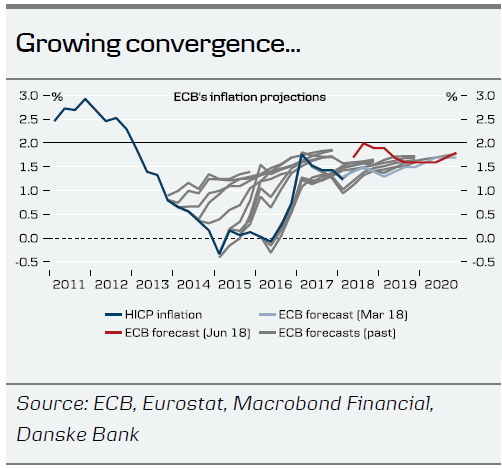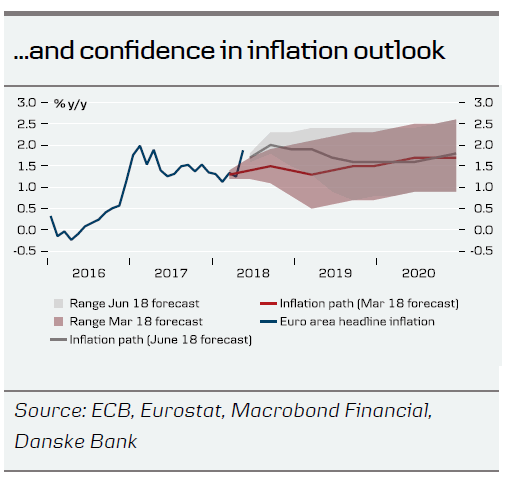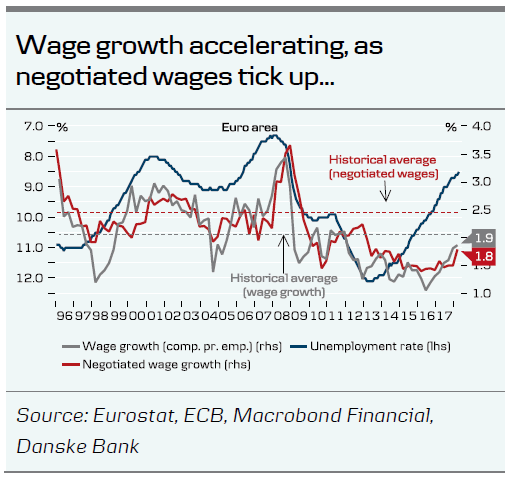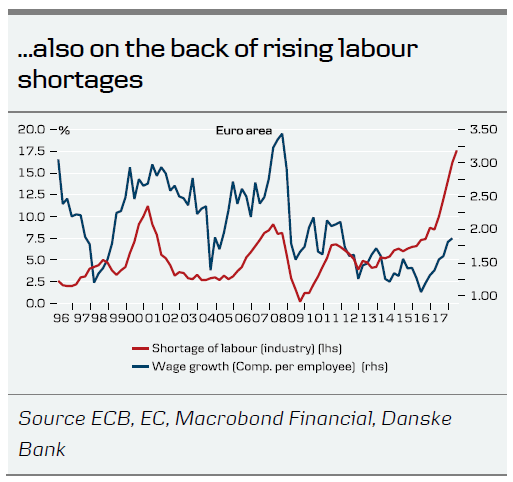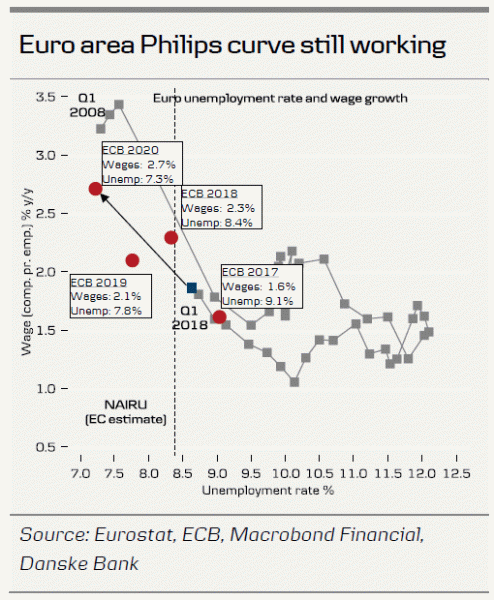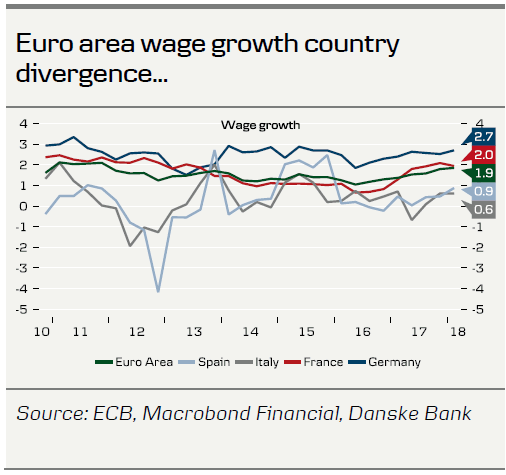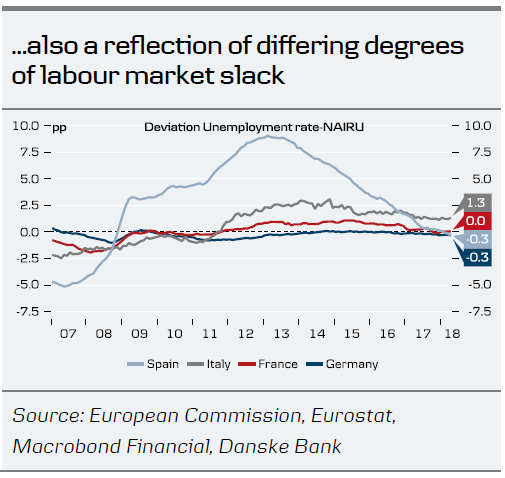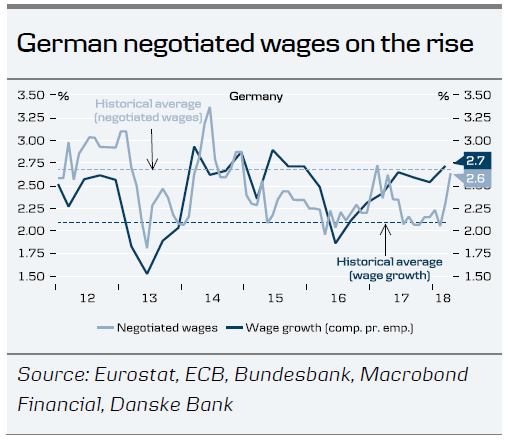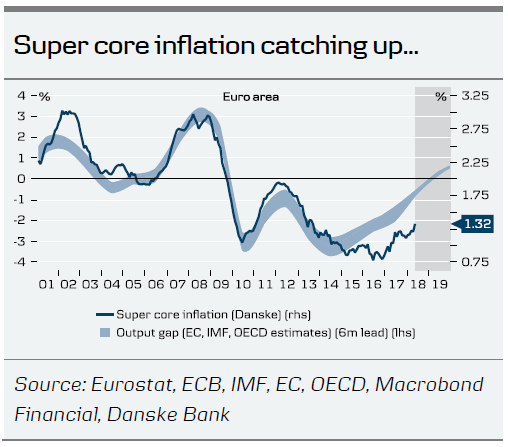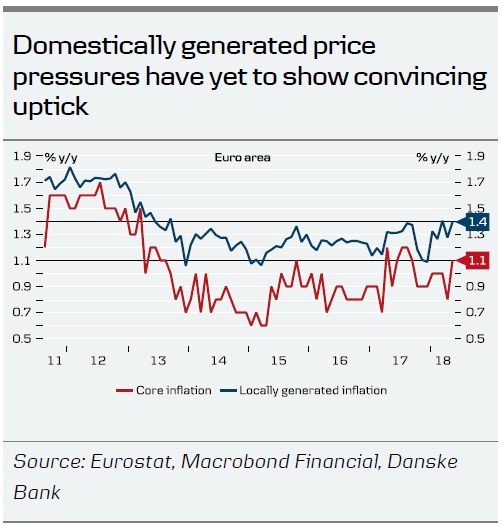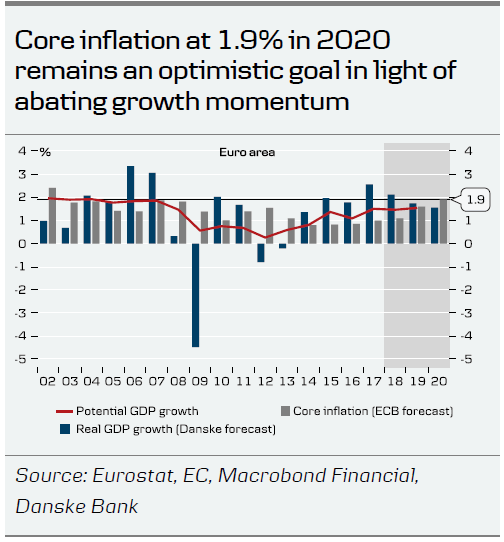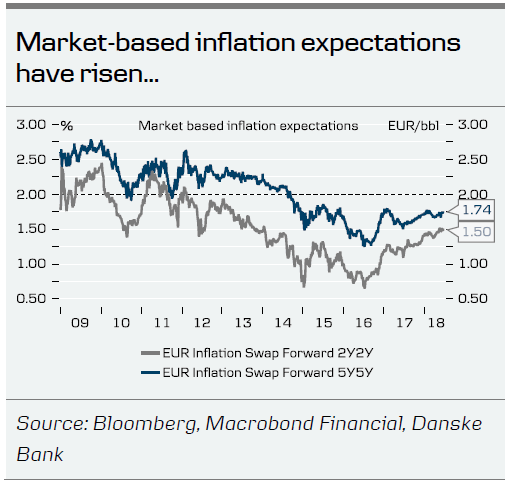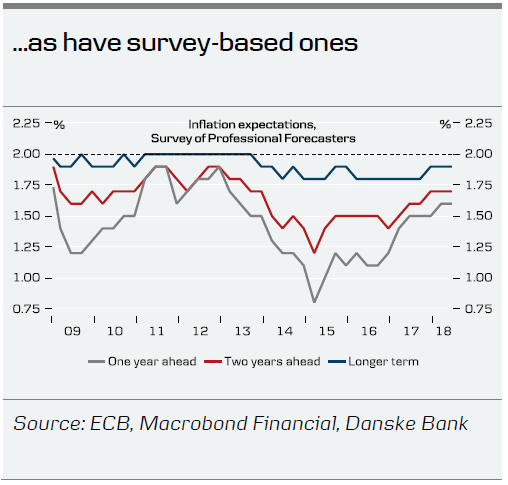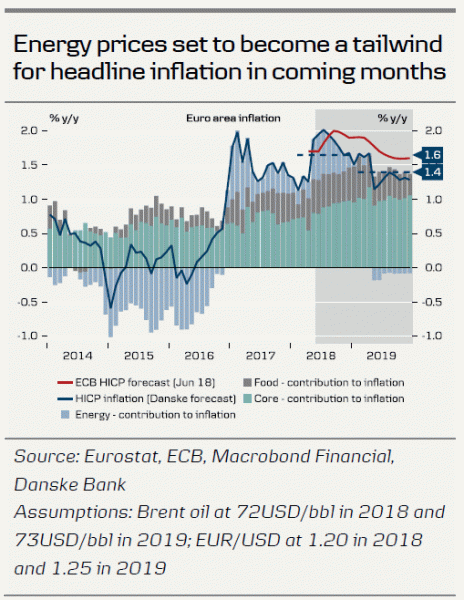- There are rays of hope for the outlook on euro area inflation and accelerating wage growth raises the prospect that the gradual rise in core inflation will continue.
- We remain somewhat sceptical on the resilience of the inflation outlook, as especially domestically generated price pressures remain muted.
- While inflation is moving in the right direction, further growth deterioration may delay the ECB’s next steps.
At the June meeting, the ECB announced an end date to its QE programme, citing growing confidence in the path of inflation towards its aim. Especially the ongoing economic expansion and the corresponding absorption of economic slack, well-anchored (long-term) inflation expectations and not least rising wage growth were mentioned by Mario Draghi as drivers behind this growing confidence.
To gauge whether SAPI (sustained adjustment in the path of inflation towards the 2% target) is fulfilled, the ECB looks at three factors: (1) convergence: (2) confidence and (3) resilience. Indeed, when comparing the ECB’s inflation projections across time, there is clear evidence of convergence, (i.e. they have become more ‘accurate’). HICP inflation has picked up from the low levels observed in 2015 or even early 2016. Deflation risks have disappeared and the ongoing expansion has given ECB President Mario Draghi and other members more confidence in the inflation outlook, reflected in the smaller confidence intervals of the projections. However, it is also fair to say that the ECB has persistently overestimated the actual inflationary pressures in recent years.
Is this time different?
A good starting point to answer this question is to look at the euro area labour market. We see signs that the Phillips curve relationship has started to work again and the rapid fall in unemployment in recent years coupled with increasing labour shortages in some countries has started to translate into higher wage growth. In particular, negotiated wages have risen from their subdued levels. A big driver for this development has been Germany, where recent bargaining rounds in the metal & electro industry, construction sector and public administration have all resulted in significantly higher wage increases compared to previous years.
While the increase in euro area wage growth to 1.9% in Q1 18 is clearly good news for the ECB, it also masks an underlying country divergence. Whereas wages rose by 2.7% in Germany and 2.0% in France in Q1, wage pressures in Spain and Italy remain very subdued, due in part to remaining slack in the labour market, with the unemployment rate lying above the natural (‘NAIRU’) level.
Several factors, not least higher inflation expectations that affect the backward looking wage formation process, speak in favour of accelerating euro-area wage growth in the future, but what ultimately matters for core inflation is the wage increase relative to productivity growth (i.e. unit labour costs). In its projections, the ECB assumes a flat profile for labour productivity growth of 0.9% over the coming years, leading it to expect a significant uptick in ULC and thereby core inflation, averaging 1.6% in 2019 and 1.9% in 2020. A rise in productivity growth, for example on the back of productivity enhancing investments, hence remains a downside risk that could weaken the wage price spiral.
Underlying inflation pressures: a mixed picture
Overall, the evidence that the recent pickup in wage growth has translated into higher underlying inflation pressures remains scant so far. Although core inflation rose back to 1.1% in May from 0.8% in April, the details reveal that the increase has been driven mostly by one-off factors (i.e. a rise in volatile travel-related items due to the different timing of Whitsun in 2017 versus 2018). Hence, we remain sceptical as to whether we will see similarly strong increases in core inflation in the coming months and expect it to reach 1.5% only towards the end of 2019.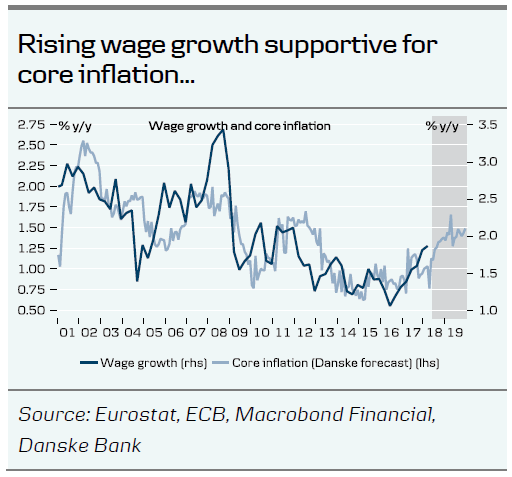
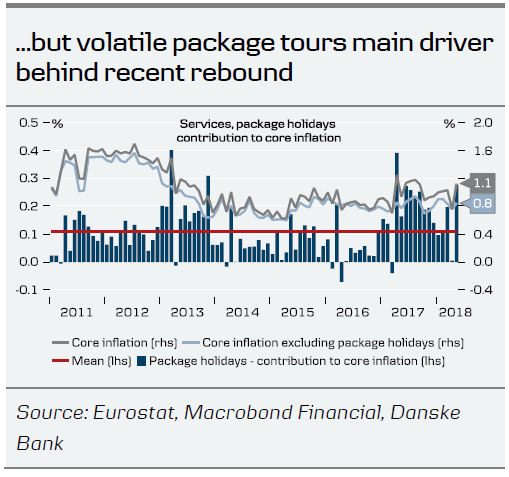
What is the evidence for rising underlying inflation pressures when we look at alternative measures of inflation? Super core inflation (which only includes HICP items linked to the output gap) edged up to 1.3% in March, which is an encouraging sign, although its responsiveness is still lagging developments in the output gap. In terms of country composition, a similar picture to wage growth emerges with core countries such as Germany and France being the key drivers.
Another interesting measure to follow is our domestically generated inflation measure, which includes only locally sourced HICP items and aims to filter out the (mostly negative) impact of international factors and globalisation. This measure has stagnated around the 1.3-1.4% level since the beginning of 2018, indicating that domestically generated price pressures have yet to show a convincing upward trend in response to recent higher wage growth even when neglecting the impact from global factors.
Negligible effects of EU tariffs on US goods
With the EU imposing 25% tariffs on EUR2.8bn of US goods on 22 June in retaliation to US tariffs on steel and aluminium, the question arises to what extent this would affect the eurozone inflation outlook.
Judging from the list of items affected, the impact should show up mainly in food and NEIG inflation. A quick ‘back of the envelope’ calculation reveals that the aggregate inflation impact should be relatively muted. EUR2.8bn constitutes only roughly 0.05% of total private consumption expenditure in the euro area and even when assuming a full 25% pass-through to consumer prices, it should only lift total HICP inflation by roughly 0.01 percentage points. Furthermore, substitution and competition concerns could further dampen the actual pass-through to inflation and the effect is likely to come with a lag due to price stickiness. Hence, at least in its current form, we do not consider EU tariffs a game changer for euro area inflation.
Eurozone inflation: growing convergence and confidence, but resilience still lacking
Overall, we share the ECB’s more optimistic view on the outlook for euro area inflation. Inflation has clearly shown signs of convergence, both market- and survey-based inflation expectations have risen and accelerating wage increases make us more confident that the gradual rise in core inflation will continue going forward. However, we emphasise that it will be a gradual rise and the ECB’s core inflation forecast of 1.9% in 2020 remains optimistic, in our view, not least because the economic momentum in the euro area is abating, with growth expected to fall back to potential by 2020. The last time we had core inflation at 1.9% was before the financial crisis in 2007, when GDP growth was 3.1% and significantly above potential.
We remain somewhat sceptical on the resilience of the inflation outlook. Although headline inflation will remain close to 2% over the coming months, this is mainly due to energy prices. In light of our and markets expectation that oil prices will not rise further, the positive contribution from energy prices will abate from late 2018 onwards. At the same time, different measures of the underlying inflation pressures in the euro area still paint a somewhat mixed picture, with especially domestically generated price pressures still muted. A recent ECB publication, which looks at different measures of underlying inflation for the euro area, arrives at a similar conclusion. Hence, we expect the ECB to stick to its mantra and remain patient, prudent and persistent.
In the right direction – but growth deterioration may delay ECB steps
Although the June meeting saw a significantly more upbeat assessment of the inflation outlook, it was also conditioned on the still very accommodative monetary policy stance. Regarding the APP impact on inflation, Draghi said that the overall impact on euro area inflation ‘is estimated by the ECB to be […] around 1.9%-points cumulative in the period between 2016-2020’.
We have argued for a while that QE could be ended because of solid growth and vanishing deflation risks, but that the timing of the first rate hike will depend on the inflation dynamics. In line with the ECB’s most recent forward guidance (‘rates will remain at present levels at least through the summer of 2019’), we still believe that the first deposit rate hike will come in only 1.5 years’ time.
While ECB is more confident on the inflation dynamics, we also take note of the more downbeat assessment on the growth outlook, in particular in light of the recent protectionism / trade war risks. In a recent interview, Chief Economist Peter Praet indicated that the end of the APP by the end of the year is not a firm decision but subject to incoming data. The ECB’s ‘anticipation’ of ending QE could be derailed if data deteriorates markedly. We would expect the ECB to change stance should the growth outlook turn significantly sour from its 2.1% expected growth this year, to somewhat below the potential growth (estimated by EC around 1.5%).




